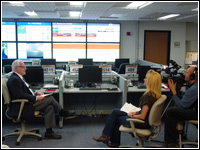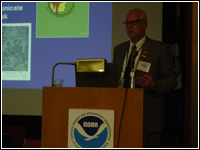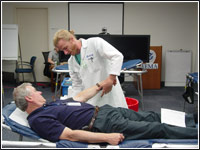Region X
Supporting the citizens and first responders of Alaska, Idaho, Oregon and Washington
What We Do
From our offices in Bothell, Washington, FEMA Region X (Ten) works with the emergency management agencies of Alaska, Idaho, Oregon and Washington to accomplish FEMA’s mission to:
Support our citizens and first responders to ensure that as a nation we work together to build, sustain, and improve our capability to prepare for, protect against, respond to, recover from and mitigate all hazards.
The states served by FEMA Region X can experience a variety of hazards including earthquakes, wild fires, volcanic eruptions, landslides and tornados as well as weather emergencies like snow, ice, wind and heavy rain.
To help accomplish FEMA’s mission Region X maintains strong partnerships through its Regional Advisory Council and Regional Interagency Steering Committee.
Constructed on the site of a decommissioned Nike missile site, the Bothell Federal Regional Center (FRC) is one of six similar operations centers built during the late 1960s. Total cost of design, construction, etc. was $1,860,000 (estimated cost of constructing a similar building in 1983 was over $25 million, and the cost today would easily exceed $40 million). The building itself is a subterranean office structure designed to be reasonably survivable in the event of foreseeable natural or man-made disasters.
Stay informed of Region X and FEMA's activities online: Follow Region X at www.twitter.com/femaregion10
Follow FEMA on Twitter www.twitter.com/fema and on FaceBook at www.facebook.com/fema. FEMA videos and podcasts available at www.fema.gov/medialibrary and www.youtube.com/fema.
News
Getting The Word Out In The Pacific Northwest
This is a Test of the Emergency Alert System
 The Emergency Alert System (EAS) is one of the most important communications tools for issuing emergency information and warnings to the public – and while it is frequently used and tested at the local level, November 9, 2011 marks the first ever nation-wide test. The 11 a.m. Pacific (2 p.m. Eastern) timing guarantees that the nation-wide test minimizes disruption during rush hour traffic and still allows for a comprehensive test during working hours across all fifty states.
The Emergency Alert System (EAS) is one of the most important communications tools for issuing emergency information and warnings to the public – and while it is frequently used and tested at the local level, November 9, 2011 marks the first ever nation-wide test. The 11 a.m. Pacific (2 p.m. Eastern) timing guarantees that the nation-wide test minimizes disruption during rush hour traffic and still allows for a comprehensive test during working hours across all fifty states.
“This EAS test plays a key role in ensuring that our nation is prepared for all hazards, and that our citizenry is able to receive critical and vital information,” said Regional Administrator Ken Murphy, during a recent interview with Seattle FOX TV affiliate KCPQ 13. “While various components of the system are tested regularly, this will be the first nation-wide, top-to-bottom test of the system.”
While most messages, such as tsunami or hurricane warnings are limited to 2 minutes by the EAS system, the Presidential message capability does not have a time limit. To validate that the system interprets the Presidential message code, the message duration time is scheduled for approximately three minutes.
West Coast Tsunami Conference
Preparing the Whole Community for Walls of Water
 FEMA Regional Administrator Ken Murphy spoke to a full house at the 21 October 2011 West Coast Tsunami Conference on the National Oceanic and Atmospheric Administration (NOAA) Sand Point campus in Seattle. Promoting mitigation and pre-disaster preparedness to reduce loss of life and property, facilitate response and speed recovery efforts in the event of catastrophic disaster, Murphy emphasized the need for engaging the Whole Community when preparing for the worst. "We've made incredible strides over the years engaging all segments of our society in disaster preparedness, but too many people still think of FEMA as this nation's Disaster Response team," said Murphy. "We're just part of the team – an important part to be sure, but still just a part of a team that includes federal. state, tribal, and local governments. A team that includes large and small businesses, non-profit and volunteer organizations and most important of all—an engaged, involved and committed citizenry."
FEMA Regional Administrator Ken Murphy spoke to a full house at the 21 October 2011 West Coast Tsunami Conference on the National Oceanic and Atmospheric Administration (NOAA) Sand Point campus in Seattle. Promoting mitigation and pre-disaster preparedness to reduce loss of life and property, facilitate response and speed recovery efforts in the event of catastrophic disaster, Murphy emphasized the need for engaging the Whole Community when preparing for the worst. "We've made incredible strides over the years engaging all segments of our society in disaster preparedness, but too many people still think of FEMA as this nation's Disaster Response team," said Murphy. "We're just part of the team – an important part to be sure, but still just a part of a team that includes federal. state, tribal, and local governments. A team that includes large and small businesses, non-profit and volunteer organizations and most important of all—an engaged, involved and committed citizenry."
Murphy's presentation followed Japan Meteorological Agency (JMA) Senior Coordinator for Tsunami Forecast Modeling Tomoaki Ozaki's keynote address on Lessons from the March 2011 Tohoku Earthquake/Tsunami, and preceded a panel on Land and Sea Response which included national and regional subject matter experts from USGS, NOAA, USN, USCG, the Washington Emergency Management Division, FEMA, and JMA.
WSEMA 2011 Annual Conference
Preparedness: It’s Not a Mystery
 More than 175 emergency managers and continuity planners from across the Pacific Northwest met in Port Angeles, Washington 27-29 September to attend the 2011 Washington State Emergency Managers Association annual conference. This year’s theme was Preparedness: It’s Not a Mystery, and FEMA Regional Administrator Ken Murphy joined with Clallam County Commissioner Mike Chapman and Washington Emergency Management Division Director Jim Mullen in underscoring the importance of joint operations—all levels of government working together seamlessly—preparing for, responding to, and recovering from disasters.
More than 175 emergency managers and continuity planners from across the Pacific Northwest met in Port Angeles, Washington 27-29 September to attend the 2011 Washington State Emergency Managers Association annual conference. This year’s theme was Preparedness: It’s Not a Mystery, and FEMA Regional Administrator Ken Murphy joined with Clallam County Commissioner Mike Chapman and Washington Emergency Management Division Director Jim Mullen in underscoring the importance of joint operations—all levels of government working together seamlessly—preparing for, responding to, and recovering from disasters.
“I’m particularly pleased to announce that we’ve published the National Disaster Recovery Framework, or NDRF and it’s now available online.” said Murphy. “It summarizes the way ahead for disaster recovery, and is the first framework published under Presidential Policy Directive/PPD-8—National Preparedness.”
WSEMA is a professional association of local, county, state and federal emergency management and individuals from the private and public sectors committed to: providing state leadership and expertise in comprehensive emergency management; serving as a vital information and assistance resource for local, county and state managers and directors, and private industry; and forging strategic partnerships to advance continuous improvement in emergency management.
Pacific NW Not Seeing (Enough) Red?
Whole Blood Supports the Whole Community
 It’s summer, and the American Red Cross and blood centers across the Pacific Northwest are asking blood donors to roll up their sleeves and give as soon—and as often—as possible. According to FEMA Regional Administrator Ken Murphy, whole blood is traditionally in short supply during the summer months due to holiday travel schedules, school break and competing priorities. But if donations are down, the demand for blood isn’t.
It’s summer, and the American Red Cross and blood centers across the Pacific Northwest are asking blood donors to roll up their sleeves and give as soon—and as often—as possible. According to FEMA Regional Administrator Ken Murphy, whole blood is traditionally in short supply during the summer months due to holiday travel schedules, school break and competing priorities. But if donations are down, the demand for blood isn’t.
“All types of blood are needed, and the American Red Cross has issued a “Type O Alert” for type O negative—which can be used to treat any patient,” said Murphy. “Donating blood is a simple, safe, and selfless gift that enhances the level of preparedness of each and every community within our region and throughout this nation.”
There is no substitute for blood and volunteer donors are the only source. To locate the nearest blood donation opportunity, call 1-800-RED CROSS (1-800-733-2767), or for those living up and down the I-5 corridor in western Washington, contact the Puget Sound Blood Center at 1-800-398-7888.
Region X Hosts 2011 National Training/Exercise Workshop
Region X played host to this year’s Regional Training Managers and Regional Exercise Officers Workshop 19-21 July at the U.S. District Courthouse in downtown Seattle. Attendees included more than 50 training and exercise managers, planners and supervisors representing all ten FEMA regions, the National Exercise Division, Office of Training, Exercises and Doctrine, and the Emergency Management Institute. Breakout sessions ranged from updates on the National Training Program, Disaster Field Training Operations and Regional Exercise Best Practices to the National Exercise Division reorganization, Thunderbolts, and Future National Level Exercises.
In welcoming workshop attendees, Regional Administrator Ken Murphy shared his own personal mantra: Today’s preparations will determine tomorrow’s outcomes. “I’m truly impressed by the sheer breadth and depth of disciplines, jurisdictions and experience levels represented at this week’s workshop,” said Murphy. “I encourage you all to be generous in sharing lessons learned— what works, what needs improvement and how you see your role in charting our shared futures.”
Washington Partners Embrace Whole Community
 The Washington Partners in Emergency Preparedness Conference is the largest and most successful regional emergency preparedness conference in the Pacific Northwest. The conference annually hosts nearly 700 people representing business, schools, government, the nonprofit sector, emergency management professionals, and volunteer organizations, and this year’s 26-27 April 2011 event was no exception. From “Developing Technology to Integrate Functional Needs” and “Are You Ready for the Maximum of Maximum’s” to “Build a Kit for Vulnerable Populations” and “Homeless Planning for Emergencies,” even a cursory scan of this year’s breakout sessions confirms a wide acceptance of Whole Community concepts. Luncheon speaker Regional Administrator Ken Murphy connected the dots on Whole Community: “Saving and sustaining lives is our number one priority, and time is our biggest enemy,” said Murphy. “No matter the scale and magnitude of the crisis, we must be ready to effectively respond in the first hours and days. Our focus must shift from incidents to individuals and from processes to products.”
The Washington Partners in Emergency Preparedness Conference is the largest and most successful regional emergency preparedness conference in the Pacific Northwest. The conference annually hosts nearly 700 people representing business, schools, government, the nonprofit sector, emergency management professionals, and volunteer organizations, and this year’s 26-27 April 2011 event was no exception. From “Developing Technology to Integrate Functional Needs” and “Are You Ready for the Maximum of Maximum’s” to “Build a Kit for Vulnerable Populations” and “Homeless Planning for Emergencies,” even a cursory scan of this year’s breakout sessions confirms a wide acceptance of Whole Community concepts. Luncheon speaker Regional Administrator Ken Murphy connected the dots on Whole Community: “Saving and sustaining lives is our number one priority, and time is our biggest enemy,” said Murphy. “No matter the scale and magnitude of the crisis, we must be ready to effectively respond in the first hours and days. Our focus must shift from incidents to individuals and from processes to products.”
Archives
Floodplain Management Guidebook, 5th Edition
This document is a local administrator's guide to floodplain management and the National Flood Insurance Program (NFIP). Click here to access the guidebook.

